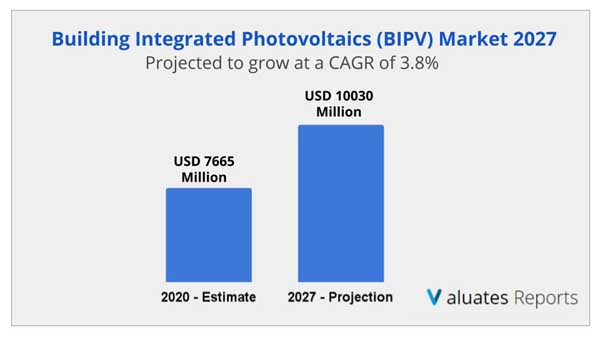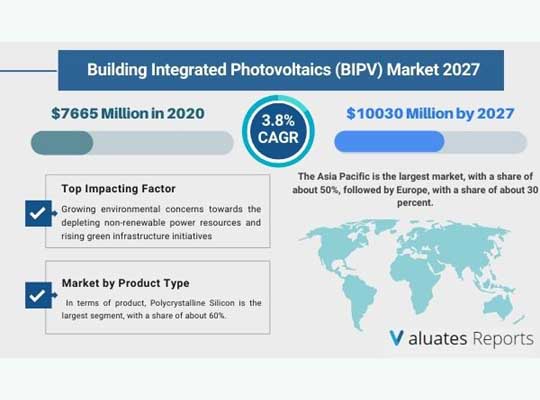BANGALORE – The Building Integrated Photovoltaics (BIPV) Market is Segmented by Type (Single Crystal Silicon, Polycrystalline Silicon, Thin Film), by Application (Residential, Commercial, Others). The report covers global opportunity analysis and industry forecasts from 2021 to 2027. It is published in Valuates Reports under Renewable & Alternative Energy Category.
In 2020, the global Building Integrated Photovoltaics market size was USD 7665 Million and it is expected to reach USD 10030 Million by the end of 2027, with a CAGR of 3.8% during 2021-2027.
Global Building Integrated Photovoltaics (BIPV) key players include Canadian Solar, SunPower, Hanwha Solar, Jinko Solar, Solar Frontier, etc. The Global top five manufacturers hold a share of about 25%.

Major factors driving the growth of building-integrated photovoltaics market:
The growing awareness of green infrastructures, such as energy-efficient buildings, as well as increased efforts by national governments to install solar energy panels, are likely to enhance demand for building-integrated photovoltaics (BIPV).
Though the initial cost of BIPV is on the higher side, it is still a more cost-effective option as it helps save money on electricity utilization over a period of time.
The recent construction trend toward highly glazed multi-story buildings especially in the developing country is expected to drive the growth of the building integrated photovoltaic market. The size, color, and shape of BIPV modules can all be changed. As a result, it can be fully integrated into the project’s aesthetic design.
TRENDS INFLUENCING THE GROWTH OF BIPV MARKET:
Growing environmental concerns towards the depleting non-renewable power resources and rising green infrastructure initiatives are expected to drive the growth of the BIPV market. Building-integrated photovoltaics not only generates clean power on-site without requiring more land but can also reduce a building’s energy usage by utilizing daylight and reducing cooling loads. As a result, BIPV can aid in the development of net-zero energy structures.
BIPV modules blend in with the surroundings and come in for a variety of building types and applications and can be integrated into a multitude of innovative ways which reduces the physical limitations of traditional PV modules. This allows the BIPV to be integrated with the building without affecting the architectural aesthetics thereby driving its market growth.
Increased efforts taken by various governments toward the use of renewable sources of energy are likely to drive the Building-integrated photovoltaics market over the forecast period.
BUILDING-INTEGRATED PHOTOVOLTAICS MARKET SHARE ANALYSIS
The Asia Pacific is the largest market, with a share of about 50%, followed by Europe, with a share of about 30 percent.
In terms of product, Polycrystalline Silicon is the largest segment, with a share of about 60%. And in terms of application, the largest application is Commercial, followed by Residential, etc.
The commercial segment is projected to witness considerable growth over the forecast period owing to the increasing awareness about zero-emission green infrastructure. BIPV installations improve the aesthetic appeal of commercial establishments and provide major savings on electricity consumption, thereby driving product deployment across the commercial segment.
Major Key Players in the Building Integrated Photovoltaics Market
- First Solar
- Sharp
- Yingli Solar
- Solar Frontier
- SunPower
- Solarcentury
- Hanwha Solar
- REC Group
- Panasonic
- Kyocera
- Canadian Solar
- Suntech
- Trina Solar
- Meyer Burger
- AGC Solar
- Harsha Abakus Solar
- Sapa Group
- ISSOL
- SolarWorld AG
- Jinko Solar
Inquire for Regional Report: https://reports.valuates.com/request/regional/QYRE-Auto-23G85/Global_Building_Integrated_Photovoltaics_BIPV_Market











